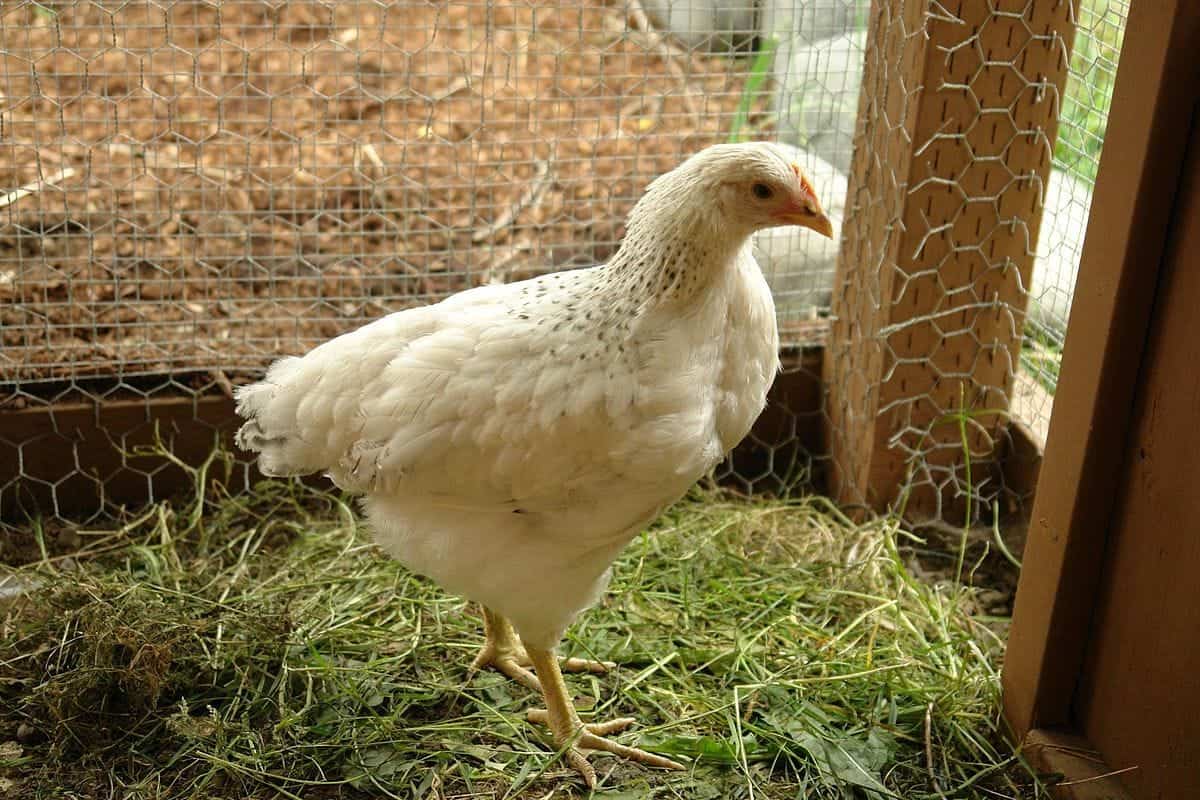Chickens are a common sight on farms and homesteads. The Delaware chicken in particular is a firm favorite for hobby farms due to their dual purpose as meat birds and layers, along with their easy-going nature. While they were once popular birds, these days, this breed is less well known.
If you haven’t heard of Delaware chickens or perhaps you want to start your own flock, this guide will introduce you to the breed. You’ll also find out why they’re not as popular as they once were, despite efforts to restore their numbers.

Quick Facts About Delaware Chickens

| Breed Name: | Delaware |
| Place of Origin: | Indian River, Delaware, U.S.A. |
| Uses: | Dual-purpose: Broiler and layer |
| Rooster (Male) Size: | 8 pounds |
| Hen (Female) Size: | 6 pounds |
| Color: | White with speckled black barring on their hackle, wings, and tail |
| Lifespan: | 5+ years |
| Climate Tolerance: | Heat tolerant |
| Care Level: | Low |
| Egg Production: | About 200 a year (approx. four a week) |
| Egg Size: | Large |
| Egg Color: | Light brown |
Delaware Chicken Origins
Originally called the Indian River chicken before their name was changed, the Delaware chicken is one of the newest breeds of chicken in the U.S.A. They were first introduced during the 1940s, when breeding programs were started for the New Hampshire and Plymouth Rock chickens to improve both breeds.
During the program, several chicks were produced that didn’t match the standards set for either of the original breeds. These chickens drew the attention of George Ellis from Indian River Hatchery in Delaware. In search of a good egg layer and broiler chicken, he set about perfecting the breed.
Delaware Chicken Characteristics
Delaware chickens are slowly coming back into favor among small farmsteads due to their temperament. They’re well known for their curiosity, tendency to roam, and strong survival instincts that keeps them wary of any potential predators.
The breed can be assertive and are often high up in the hierarchy in mixed-breed flocks, but they don’t often resort to bullying. For family-owned farms, these chickens are also favored due to their docile nature toward children. Many owners have noted how talkative the breed is too. While they’re not overly noisy, their tendency for chattering as they follow you around the yard may be bothersome to your neighbors.
Production-wise, Delaware chickens excel at both egg-laying and being meat birds. They yield about 200 large, light brown eggs a year —approximately four a week — and they have a decent amount of meat on their carcass.
Mature hens come in at about 6 pounds, while roosters weigh between 7 and 8 pounds. The Bantam varieties favored by smaller homesteads weigh between 28 ounces for the hens and 32 ounces for the roosters.
As a relatively healthy breed, Delaware chickens are easy to care for, especially for new farmers, and can live for more than 5 years if taken care of properly. A well-balanced diet of layer feed — pellets or crumble — and access to clean water will help you keep your flock healthy. They should have at least 8 feet of coop space each, with several 12-inch square nesting boxes for the hens.
Uses
For the first 20 years of their existence, Delaware chickens ruled the roost as the top broiler chickens in the U.S.A. Their egg-laying capabilities fell to the wayside in favor of their quick maturity and the quality and amount of meat that they carried. Despite starting successfully, however, the introduction of the Cornish Cross led to the Delaware chicken’s early retirement as meat birds.
These days, having been saved from extinction by a few loyal breed enthusiasts, Delaware chickens are a dual-purpose bird. They’re steadily growing in popularity among homesteaders for their egg-laying capabilities and meat production.
Appearance & Varieties
Overall, there is only one standard for Delaware chickens. Since they were only truly popular for about 20 years before falling into decline, they never really made it out of the U.S.A. This limited distribution means there aren’t many variations on the standard that was established by George Ellis, the original breeder, and the American Poultry Association Standard of Perfection.
Delaware chickens are mostly white with black barring on their hackle, wings, and tails. They’re often mistaken for having Colombian coloring, but they have a few differences, mainly the barred patterning.
As medium-sized chickens, they have robust bodies, and their combs have five distinct points. The Delaware’s comb, wattle, and ear lobes are all red, while their feet and beaks are yellow.
Despite only being known in the U.S.A., Bantam varieties are available. They are similar in appearance, albeit on a smaller scale.
Population/Distribution/Habitat
The Delaware chickens’ original intention as broiler birds worked against the breed when the Cornish Cross usurped their position as the leader of the meat industry. With their focus on producing food for commercial use, Delaware chickens weren’t well known among small farmers and homesteaders. Without their support, the population of the Delaware
rapidly declined. The efforts of a few, steadfast homesteaders kept the breed going long enough for the Livestock Conservancy to get involved. In 2009, the Delaware chicken population was listed as critical, and efforts to restore the breed are ongoing.

Are Delaware Chickens Good for Small-Scale Farming?
Dual-purpose birds are perfect additions to small-scale farming. The Delaware in particular is both easy to care for and docile. Their egg-laying and meat production make them good for homesteads because they enable families to use their eggs and carcasses for meals.
It was originally small-scale farmers and homesteaders who prevented the Delaware chicken from going extinct after the introduction of the Cornish Cross. Through the efforts of new Delaware owners, the breed is slowly coming back into popularity as a favorite among hobby farms in particular.
Related reads:
Featured Image Credit: Gunnar Rathbun, Shutterstock
